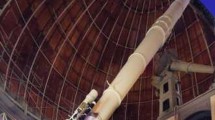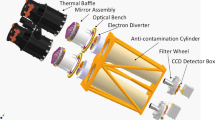Abstract
In 2009, the Centre National d’Etudes Spatiales (CNES) carried out an assessment study on a “Fresnel telescope” concept based on a two-spacecraftformation flying configuration. This concept uses a binary Fresnel zone plate, and the principle of diffraction focusing, which allows high resolution optical imaging for astrophysics. In addition to CNES, the Laboratoire d’Astrophysique de Toulouse Tarbes (LATT) was deeply involved at two levels: through Research & Technology (R&T) studies to simulate and validate on a test bench the Fresnel concept performance, and through active participation in the CNES team for the optical aspects and to define the astrophysical fields of Fresnel-based space missions. The study was conducted within the technical limitations that resulted from a compromise between the R&T state of the art and the potential scientific domains of interest. The main technical limitations are linked to the size of the primary Fresnel array and to its usable spectral bandwidth. In this framework, the study covers ambitious architectures, correlating the technology readiness of the main critical components with the time-scale and programmatic horizons. The possible scientific topics arise from this range of missions. In this paper, I present a mission launched by a Soyuz, dedicated to astrophysics in the Ultra Violet (UV) band: 120 to 300 nm using a 4-m Fresnel array. It could be competitive in the next fifteen years, whereas a 10-m aperture mission in different bands; UV, visible or Infra Red (IR) (up to 6 μm) could be achievable in the future. Larger missions, using a primary array larger than 20 m, request technologies not yet available but that will probably be based on new inflatable structures with membranes, as already tested in the USA for other ends.























Similar content being viewed by others
References
Koechlin, L., Serre, D., Duchon, P.: High resolution imaging with Fresnel interferometric arrays: suitability for exoplanet detection. Astron. Astrophys. 443, 709 (2005)
Fresnel, A.: Mémoire sur la Diffraction de la Lumière. Academie des Sciences, Paris. Available online: http://www.academie-sciences.fr/membres/in_memoriam/fresnel/fresnel_pdf/Mem1818_p339.pdf. 29 Juillet 1818
Soret, J.-L.: Sur les phénomènes de diffraction produits par les réseaux circulaires. Arch. Sci. Phys. Nat. 52, 320–337 (1875)
Serre, D.: L’imageur Interférométrique de Fresnel: Un Instrument Spatial pour l’Observation Haute Résolution Angulaire. Ph.D. thesis, Université de Toulouse, 4 Oct 2007
Hinglais, E.: Rapport d’Étude PASO, Imageur de Fresnel. CNES, Toulouse (2009)
Raksasataya, T.: Fresnel space imager for ultraviolet space mission: accretion discs. Exp. Astron. (2011). doi:10.1007/s10686-011-9221-x
Gomez de Castro, A.I.: The Fresnel space imager as disk evolution watcher. Exp. Astron. (2011). doi:10.1007/s10686-011-9223-8
Deba, P.: Preparing the way to space borne Fresnel Imagers: space scenarios optical layouts. Exp. Astron. (2011). doi:10.1007/s10686-010-9202-5
Duchon, P.: Note Technique, Exigences Générales pour le Contrôle de la Formation Bisatellitaire Constituant un Imageur de Fresnel. CNES, Toulouse (2007)
Dupuy, C.: Note Technique, Technologies de Structures dÉployables et Membranaires Souples. CNES, Toulouse (2009)
Meyssignac, B.: Mémo Technique, Zoologie des Orbites Possibles pour Fresnel. CNES, Toulouse (2008)
Duchon, P.: Mémo Technique, GNC de l’Imageur de Fresnel. CNES, Toulouse (2009)
Author information
Authors and Affiliations
Corresponding author
Rights and permissions
About this article
Cite this article
Hinglais, E. A space Fresnel imager concept assessment study led by CNES for astrophysical applications. Exp Astron 30, 85–110 (2011). https://doi.org/10.1007/s10686-011-9218-5
Received:
Accepted:
Published:
Issue Date:
DOI: https://doi.org/10.1007/s10686-011-9218-5




